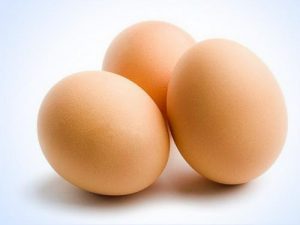
Avangard agricultural holding, the largest egg producer in Ukraine, cut monthly production by 50% over the past year due to pressure from law enforcement officers, largely due to the impossibility of organizing the export of its products in such conditions, owner of the agricultural holding Oleh Bakhmatiuk has said. “We now produce 170 million eggs a month, and we produced about 300 million, and in May – 350 million! Of which 170 million were exported in May, and this month we will send for export, maybe 20 million,” he said is in an interview with the Interfax-Ukraine agency.
Bakhmatiuk explained that the company used credit lines for $ 60-70 million for export, since delivery, for example, to Singapore takes 45 days and the supplier needs to be granted a delay.
“But thanks to the valiant actions of the NABU (the National Anti-corruption Bureau of Ukraine), all credit lines were closed to us, we were forced to almost completely close the export direction,” the Avangard owner said, adding that the coronavirus pandemic complicated logistics by making it longer and 30% more expensive.
According to him, out of seven trading houses – in Hong Kong, Singapore, Malaysia, Iraq, Liberia, Saudi Arabia and Dubai, the opening of which took six years and about $ 25-30 million, Avangard retained only one – in Dubai.
Talking about other reasons for the reduction in production, Bakhmatiuk named a painful rise in the price of raw materials, in particular, fat and oil, bagasse and cereals, common for the entire sector.
“This reputational war has been added to the general problems of the sector. In fact, 12 poultry farms have been closed, now the 13th will be closed,” he said, adding that there are 13 operating factories left.
As the businessman noted, such a reduction in production, taking into account fixed costs, led to an increase in the cost of an egg by about 20 kopecks.
Commenting on the rise in egg prices in Ukraine, he called it forced.
“We go to zero profitability and even with a small minus. Because feed prices are growing faster than the demand and the price of eggs are growing,” the businessman explained.

Ukrainian furniture manufacturers in January-March of this year increased their furniture exports by 50% compared to the same period in 2019, to $247.4 million, while in the past five years (2015-2020) there was an annual increase of 13.5%, a member of the Ukrainian Association of Furniture Manufacturers (UAFM) Oksana Donska has said. “Due to COVID-19, the global supply chains have changed a lot. Ukrainian furniture is becoming more and more interesting for the international community of professional buyers,” she said at a press conference on the problems of timber market legislation organized by the RivneInvest agency in Kyiv.
According to her, today a transparent timber market is very necessary for Ukrainian furniture manufacturers.
“The furniture and woodworking industries of Ukraine create a product with high added value. Each hryvnia of wood value turns into UAH 30-50 of the cost of furniture supplied both to the domestic market and for export,” she said.
Donska said that today more than 100,000 people work in the furniture industry for more than 9,000 enterprises, and the export of Ukrainian furniture for the past five years has been growing by 13.5% annually. Furniture is exported to 119 countries, including Poland (more than 35% export), Germany (16%), Denmark, Austria, Romania, and France. Poland and Germany use Ukrainian furniture for further sale in the world.
“But compared to the same Poland, which has approximately the same forest resources, we export 20 times less – if Poland in 2020 exported furniture worth $14.8 billion (the third largest exporter in the world), then Ukraine for only $750 million (39th place),” Donska said.
She said that on June 15 through June 17 2021, Ukraine expects about 2,000 guests from 53 countries who will come to visit the Furniture of Ukraine Business Expo (FUBE-2021) organized by the UAFM with the support of the Ministry of Foreign Affairs and the Ministry for Development of Economy, trade and Agriculture.
“However, today the Association receives appeals from our members who complain about serious problems in their work due to the stagnation of the timber market. As a result, furniture makers do not receive furniture components on time, and contracts for the supply of finished furniture with retailers from Ukraine are broken. Ukraine’s reputation is on the line if it fails to implement contracts for the supply of furniture to the countries of Europe, Asia and America. If this situation continues for several more months, then Ukrainian enterprises will have to think not about development, but about survival,” Donska said.

The Ukrainian airline WINDROSE airlines has already connected nine cities of Ukraine with a network of domestic air transportation: Kyiv, Lviv, Ivano-Frankivsk, Kharkiv, Dnipro, Odesa, Kherson, Zaporizhia and Mykolaiv. And Chernivtsi will join the flight map in June.
At WINDROSE airlines, the schedule is thought out to the smallest detail. Three times a day, the aircraft fly from the regions of Ukraine to Kyiv, where Boryspil airport is a hub. From here, passengers can continue their journey to other Ukrainian cities using a convenient flight connection. Transit takes up to 1.5 hours.
Schedule stability and flight regularity are essential benefits of WINDROSE’s domestic travel program. Passengers are not collected for weeks, adjusting the departure date to all possible international flights of other airlines. Passengers do not have to worry that the flight will be canceled at the last moment, and the next one will be only in a week. Flights to every Ukrainian city are guaranteed to take place daily.
WINDROSE airlines has expanded its fleet with ATR-72-600 passenger aircraft, which are designed specifically for regional transportation. The planes are comfortable and new (the oldest one is only five years old). Now it is the youngest and most modern fleet in Ukraine.
WINDROSE airlines does not intend to fill any seats on the aircraft. By taking measured steps, the Ukrainian airline is creating a new habit – to fly within Ukraine. To experience the benefits of such a trip, it is worth taking a flight with WINDROSE airlines – after all, a modern person has to appreciate his time and comfort.
Ticket prices are quite reasonable:
* For early booking, the price is from UAH 870;
* The average ticket price is about UAH 1,500;
* For passengers who travel frequently, there is a unique opportunity to purchase an airline fare.
WINDROSE is the airlines that unite!

Ukraine in January-March 2021 increased imports of coal and anthracite (foreign economic activity code 2701) by 18.6% (by 813,072 tonnes) compared to the same period in 2020, to 5.194 million tonnes. According to the State Customs Service, coal was imported for $474.508 million, which is 0.4% more than in January-March 2020 ($472.525 million).
The Russia supplied coal worth $286.862 million (the share of imported coal is 60.45%), the United States for $107.046 million (22.56%), Kazakhstan for $56.851 million (11.98%), other countries for $23.75 million ( 5.01%).
Ukraine’s export of coal over the first three months of 2021 amounted to 204 tonnes for $25,000, while in the first quarter of 2020 it was not exported. In particular, export to Hungary was worth $11,000, Belarus some $7,000 and Bulgaria some $7,000.

Pharmaceutical company Lekhim (Kyiv) as an official representative of the Chinese vaccine manufacturer Sinovac Biotech plans to transfer the first batch of the Chinese CoronaVac vaccine against coronavirus (COVID-19) disease to state-owned enterprise Medical Procurement of Ukraine after the completion of laboratory control on Saturday.
“The laboratory control ends tomorrow. We have no result yet, it will be tomorrow, and tomorrow we will deliver the vaccine to the Medical Procurement of Ukraine. This issue has already been settled, they confirmed the delivery address,” the company told Interfax-Ukraine on Friday.
Lekhim said that the Medical Procurement of Ukraine will be engaged in further delivery of the vaccine.
In addition, the company confirmed negotiations to extend the contract with Sinovac by another 5 million doses.
“The issue of increasing the volume of contact has been discussed, but there is still no concrete answer from the Chinese side. We expect information from them next week, but the already purchased 1.9 million doses should be delivered, although the terms are constantly shifting,” the company said.
As reported, on April 8, the Medical Procurement of Ukraine confirmed to Lekhim its readiness to accept the supply of the COVID-19 vaccine produced by Sinovac Biotech Ltd. under a procurement agreement for the national budget’s funds.